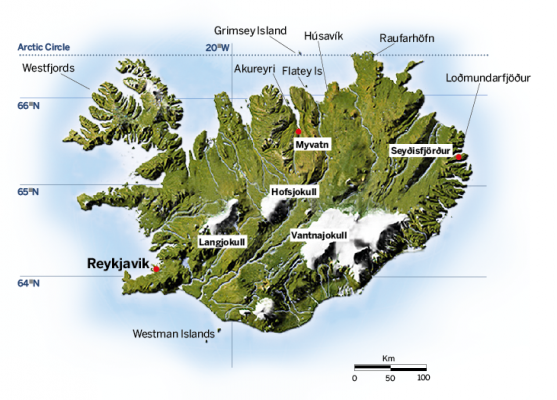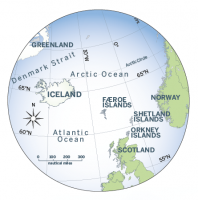James Stewart joins the crew of expedition yacht Hummingbird for an exploration of the wilder parts of Iceland
Back on land we had joked with locals about the lousy summer Iceland was having. Now, with the windchill at sea sending temperatures towards freezing, reality had bitten. I was glad to see Grimsey’s tiny fishing harbour appear.
What the hell were we doing here? I wondered as I took a spring line to a bollard. While the UK was sizzling under an unseasonal heatwave, I was shivering despite two sets of thermals. My hands stung with cold.
A signpost pointing from the harbour provided the answer. It read simply: ‘Arctic Circle.’
Roald Amundsen said grandly that adventure was just bad planning. For us mere mortals, however, you couldn’t define it better than high-latitudes sailing. I’d wanted to go for ages. The trouble is how many of us have the time or, if we’re honest, the inclination for the passage?
That’s where the company Rubicon3 comes in. Under the motto ‘sail, train, explore’, its yacht Hummingbird is on her second high-latitudes cruise of 2015. A first-generation Clipper 60 (ex-Blackadder), she’s purpose-built for the job.
Below decks there’s insulation and heating, and there’s a USB charger above each bunk in the cramped crew quarters. Otherwise, she’s the same bulletproof raceboat that went three times round the world, with a powerful cutter-rig sail plan and enough bits of string to entertain a large crew.
Exploring remote cruising grounds
Hummingbird spends her summers exploring some of the remotest cruising grounds in the North Atlantic and welcomes all aboard: from experienced sailors who want to hone their technique with the pros to novices who don’t know their stern from their elbow.
She had ticked off the German Baltic, Sweden, south Norway and the Faroe Islands when I joined at Seyðisfjörður on Iceland’s east coast. When I disembarked at Akureyri, Iceland’s second city after Reykjavík, she was bound for the Westfjords then Greenland. The start and end points of each leg are fixed. Beyond that anything goes.
“That structure of a journey – of an end point that’s different from your start – is really important to us,” said Rachael Sprot, co-owner of Rubicon3 and skipper of Hummingbird. “It makes it more of an adventure for everyone, including me.” That word ‘adventure’ again – it was what we’d come for.
We were ten aboard: eight paying crew, only two of us with much sailing experience, plus Rachael and Olly Cotterell, skipper of OneDLL in the 2013-14 Clipper race, so no stranger to making these boats fly.
However, we were all first-timers in Iceland. We’re not really sure what to expect, Rachael said when I came aboard at Seyðisfjörður’s wharf, where Hummingbird was moored beside a rugged 50-footer. Aside from a Scottish gaffer bound for Greenland, it was the last yacht we saw.
The surprise is more crews aren’t tempted this way. While there are no yachting facilities in east and north Iceland, sheltered fishing harbours are at convenient intervals, each with a hot swimming pool at bargain prices thanks to Iceland’s abundant geothermic power. Just leave your modesty at the door: a changing room diagram details exactly which body parts to wash beforehand – nude, of course.
 Nor is navigation too tricky, occasional fog aside. Tides are only around 1m, charts are good, depths are generous and RNLI-orange lighthouses mark headlands.
Nor is navigation too tricky, occasional fog aside. Tides are only around 1m, charts are good, depths are generous and RNLI-orange lighthouses mark headlands.
It helps too that in June and July the sun barely dips below the horizon, softening the daylight and gilding the clouds.
If you’ve still got the jitters, the Icelandic Coastguard provides reassurance. It requests that foreign yachts radio in their passage plans and arrivals. When Hummingbird’s AIS dropped out for an hour, it hailed us by VHF and diverted a fishing boat our way.
Big scenery
Most of north and east Iceland looks fantastic. You think you know about big scenery after the Scottish Highlands. Iceland reveals that you haven’t a clue.
The east coast is notched by deep fjords, the north is one of broad bays crowded by angular mountains and walls of cliffs. No one can live here, you think as you sail past another vertiginous coastline. Then a headland opens to reveal a red-roofed farmhouse on a tiny bay.
With a population of 1,500, Seyðisfjörður is a metropolis by local standards. The largest town on the east coast, it leads a double life as a commercial port and an oversized village of tin-roofed houses and craft shops selling Icelandic knitwear. You don’t sail in Iceland to go shopping, however. Loðmundarfjöður around the corner is where it begins to deliver the goods.
In the couple of hours it takes to motorsail to the fjord, houses peter out and the scenery takes over. There’s nothing there but deep black water and icy mountains peeling into the distance. Only waterfalls and chittering fulmars break the silence.
Anchored in 20m, tricked by the half-light, we lingered in the cockpit till midnight. Why would anyone come to Iceland to learn to sail? I asked one beginner. “For this,” he said, waving at the peaks. “This is adventure.”
I could have pottered in Hummingbird’s inflatable kayak for days. But with an Arctic gale forecast we called a meeting and decided to make westing. The distance to Raufarhöfn was 180 miles, so it would be an overnighter, if the term meant anything in an Icelandic summer.
Near the coast, rivers seemed to cascade from the sky, pouring as waterfalls from cliffs whose summits were furred in cloud. Further out, dolphins revolved like cogwheels at the bow. Just occasionally, a minke whale arced from the blue-black sea.
I was at the helm when several fins rose. They grew into rubbery spikes – too tall for dolphins now – then, barely a boat-length away, smooth bodies broke the surface like submarines. As the pod dived beneath Hummingbird I caught a flash of brilliant white – orcas!








